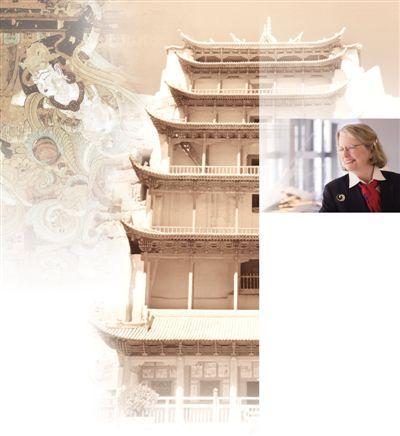
“Dunhuang is a kaleidoscope of Chinese art. In Mogao Grottoes, you can view the scenes of everyday life in ancient China, appreciate the early landscape paintings, and learn about the past and present life depicted in Buddhist culture. For example, my favorite cave No. 285, it was born in the Western Wei Dynasty. During the Datong Period (AD 538). During this period, the Central Plains culture began to infiltrate into Dunhuang, so there are images in Chinese mythology, such as flying, Fuxi, Nuwa, and Hindu gods. Luo Tian, Pi Na night, etc. Cave 285 reflects the diversity of Dunhuang culture and the influence of Chinese culture."
Ni Mi-Gates (pictured), winner of the 2017 Chinese Government Friendship Award. Before seeing her, I can hardly imagine that the beautifully dressed and talkative American lady talked about the distant Dunhuang, and she would endure a lot of things. Ni Mi is a famous American art history expert, the former Yale University Art Museum and the curator of the Seattle Art Museum. From the time of her youth in the classroom of Stanford University and the Chinese art "unexpected encounter", her fate with China has been extended for most of her life. Today, Ni Mi, who is over 70 years old, will place his obsession with art in China and place it in Dunhuang in the depths of the northwestern desert.
At first sight of Chinese art
Talking about the art work that has been in business for more than half a century, Ni Mi-Gates has the most love for her and her love for China and Dunhuang. The youthful years immersed in the long history of Chinese history are the prelude to her connection with Dunhuang art. Ni Mi said that her deep affection for Chinese art began in the course of the university era - "The History of Asian Art", "Chinese art always touches my heart. I like the era of Chinese history, such as the Five Dynasties and Ten Countries. In the Northern and Southern Dynasties, these dynasties gave birth to national integration and cultural integration, and their art also reflected the diversity and weight of ancient Chinese culture."
In 1985, Ni Mi went to Peking University to study Chinese. Here she got a precious gift - the Chinese name "Ni Mi". "The professor of Peking University who named me said that the wording of the surname means the margin, and the meaning of the name is intimacy. Together, even if you are far away, you can maintain a close relationship with China."
This beautiful name is like a prophecy of Ni Mi's future life. After graduating from the Department of Asian History at Stanford University, she received a master's degree in Oriental and Chinese Studies from the University of Iowa and a Ph.D. in Art History from Yale University. Stepping out of the ivory tower, Ni Mi has worked at the Yale University Art Exhibition Hall and the Seattle Museum. He has curated numerous exhibitions related to Chinese art in the United States and created several “first times” in the history of American exhibitions.
In 2001, Ni Mi promoted the "Ancient Treasures of the Ages - China's Sichuan Ancient Cultural Relics Exhibition", and brought the Chinese Sanxingdui artifacts to the United States for the first time. The preparations for this sensational China National Treasure Overseas Exhibition have been twisted and twisted, which took five years. In order to reassure the Chinese side, Ni Mi wrote to the Director of the Sichuan Provincial Cultural Relics Administration and made several trips to Sichuan for consultation. In the end, the exhibition was a great success in the United States.
This kind of exhibition experience is not accidental in Ni Mi's career. In order to let the "ordinary people" of the United States get a glimpse of Chinese cultural relics, Ni Mi ran around and spent a lot of effort. She smiled and said that Chinese art, which was “occupied” in the classroom when she was young, became a lifelong love in her life and became a career pursuit.
Love the treasure house of desert art Dunhuang
In mid-summer 1998, Ni Mi first came to Dunhuang. During the short stay, she spent half a day watching the cave, reading the materials in the library for a long time, immersed in the exquisite murals, colorful sculptures and mysterious scrolls, and the legend could not extricate themselves. "During the millennium, Dunhuang was a veritable global metropolis. Until the 14th century, it has been a distribution center between Greece and Rome, Persia and the Middle East, India and Chinese culture, and it has blended the treasures of Eastern and Western culture and art. Ni Mi said to me, "More importantly, the cultural relics of Mogao Grottoes are authentic, and most of them have exact time records. Many of the artistic relics in the Central Plains of China, especially the Buddhist art relics, have been damaged to varying degrees. It is a miracle that the treasure house of Dunhuang’s art in the desert is completely preserved. I love Dunhuang alone."
In 2009, Ni Mi stepped down as the curator of the Seattle Museum. Before retiring, she frequently traveled between Beijing, Shanghai and Dunhuang, actively promoting Chinese cultural relics to the United States to exchange exhibitions; after retirement, she contacted the Dunhuang Academy non-stop to discuss how to build a bridge of cooperation between the United States and Dunhuang.
In November 2010, Fan Jinshi, the then dean of the Dunhuang Academy, received a letter from Ni Mi, full of love for Chinese history and culture and a special liking for Dunhuang art. Fan Jinshi, who was deeply touched, immediately wrote back and welcomed her to visit. Three months later, Ni Miru arrived as soon as possible, and the two “Dunhuang fans” of Yizhongyimei saw the future of Dunhuang together.
Ni Mi recalled: "Mr. Ji Xianlin once said that Dunhuang is China and Dunhuang is a world. Dunhuang is a unique cultural heritage and a wealth for all mankind. I am confident that Americans will come to protect Dunhuang." After discussing with Fan Jinshi, Ni Mi registered and established the Dunhuang Foundation in the United States to protect the Dunhuang Grottoes and promote the public to understand Dunhuang art. With her many years of networking in the American art scene, she has been actively engaged in bridgemaking, and the Foundation has raised nearly $6 million in donations. In September 2016, Ni Mi was awarded the honorary title of “Dunhuang Award” by foreign experts in Gansu Province in 2016 for his contribution to the protection of Dunhuang culture. In September 2017, she was awarded the highest honor of foreign experts in China. - Chinese Government Friendship Award.
Moved Mogao Grottoes to the United States
Ni Mi noted that Dunhuang’s reputation in the United States is far less than that of the Great Wall and Terracotta Warriors. So, she proposed a bold plan: "moving" Mogao Grottoes to the United States for an exhibition! However, if you really want to experience the beauty of Dunhuang, you need to stand in the cave to see and feel, and you can harvest the amazing artistic experience. How can we make American audiences feel like this? Ni Mi and his colleagues made an amazing decision when planning the exhibition plan: 3 realistically hand-painted replica grottoes were displayed in a 1:1 ratio.
For this unprecedented exhibition plan, Ni Mi contacted the Getty Protection Institute, the Dunhuang Foundation and the Dunhuang Research Institute. Although as early as 1988, the United States' Getty Protection Institute established contact with the Dunhuang Institute and made many progress in the protection of cultural relics, but it has not been able to effectively promote overseas exhibitions until the intervention of Ni Mi, which prompted Mogao Grottoes to go. Beauty is really a trip. She coordinated the Chinese and American tripartite institutions with the chief curator of the Getty Research Center, Marcia Reed, and the Honorary Dean of the Dunhuang Institute, Fan Jinshi, overcoming the difficulties of distance, culture and language, and launching transoceanic cooperation.
Ni Mi said: "We plan to lend Dunhuang cultural relics from Britain, France, Russia and other countries to reunite the lost Dunhuang pearls." However, if you can borrow Dunhuang paintings, embroidery, rare books, etc. In the treasures of the world's major museums, everyone is playing drums. In the end, the British Museum, the British Library, and the National Library of France readily agreed to lend a total of 43 Dunhuang cultural relics, including the world's oldest complete printed book, the Diamond Sutra in 868 AD. This result is inseparable from Ni Mi’s good reputation and multi-party connection and active travel in the field of cultural relics protection for many years.
Compared with the four "borrowing" cultural relics, it is time-consuming and labor-intensive to build a hand-painted replica grotto: for the construction of three replica caves, the first building of the Getty Central Square in the United States will be added for the first time; for the perfect presentation of Dunhuang art, the hand-painted replica grotto must Keeping improving, from photographing photos to the original size of the cave wall, to the contours, the original caves are presented as they are, and even the materials are “digging” from the river bed near Dunhuang. The final visual effect of the three replica caves is very close to the real caves and is amazing.
On May 7, 2016, the $3 million, five-year preparation, the Dunhuang Mogao Grottoes: the Buddhist Art on the Chinese Silk Road, co-sponsored by the Dunhuang Institute of China, the Getty Protection Institute of the United States and the Dunhuang Foundation Exhibition, opening at the Getty Center in Los Angeles, USA. The exhibition condenses the essence of Dunhuang art. A total of three Mogao Grottoes are replicated in the cave, and a 3D virtual cave is displayed. At the same time, 43 pieces of Dunhuang Zangjing Caves that were borrowed from other museums were exhibited. This is the first time after more than a hundred years of Dunhuang remnants that have flown overseas.
Recalling this exhibition, Ni Mi is still excited and fascinated. She said: "A lot of people have questioned before the exhibition that there will be people watching the copy. The result exhibition attracted more than 200,000 spectators and received rave reviews. Dunhuang art is the window to understand Chinese culture. The exhibition has made many American audiences the first. I have known this mysterious oriental art sacred place and let them personally feel the depth, richness and beauty of Chinese history."
